
Dark Matter and The Dinosaurs
- The astounding interconnectedness of the universe -
Category: SCI
Published: 2015
#1623b
Lisa Randall
16z21u/18227r
Résumé
Remarks
>Top 0. Introduction:
- Dark matter: astronomers detect its gravity but that doesn't emit or absorb light.
- Dinosaurs were the dominant terrestrial vertebrates from 231 to 66 ma.
- Dark matter might ultimately (and indirectly) have been responsible for the extinction of the dinosaur.
- 66 ma, an object 10 km wide plummeted to Earth from space and destroyed \franc34 of species on the planet.
- Chicxulub impactor 10km across hit the Earth 66M yeas ago (K-Pg boundary).
- During the Sun's passage through the mid-plane of the Milky Way, the Solar System encountered a disk of dark matter that dislodged the distant object.
- The disk's gravitational influence would be unusually strong. Its gravitational pull could be power full enough to dislodge comets at the outer edge of the Solar System.
- This book is the story of our unconventional proposal about just such surprisingly influential dark matter.
- >Top Geologists deduced the nature of the extinction only in 1970s-80s.
- Astronauts had landed on the Moon and seen crater up close presenting with detailed evidence of the dynamic nature of the Solar System.
- In 1990s scientists discovered the Cooper belt objects in Pluto's vicinity.
- How the Universe has evolved:
- Dark matter constitutes 85% of the matter in the Universe; ordinary matter only 15%.
- the Solar System; meteoroid strikes that occur at regularly spaced intervals of about 30M years.
- the five major mass extinctions.
- meteoroids, asteroids, and comets
- the dark matter:
- thinking more broadly about the dark matter - asking why the dark universe should be so simple when ours is so complicated.
- what if some of the dark matter experiences influential non-gravitational interactions too?
- If true, dark matter forces could lead to dramatic evidence of connections between elementary matter and macroscopic phenomena even deeper.
0. 序文:
- 暗黒物質(暗黒物質);
重力は検知。光の発光・吸収はなし
- 恐竜支配の時代: 231-66 ma(百万年前)
- 66maに直径10kmの隕石落下。生物の3/4が絶滅
- 隕石落下速度: 20 km/s (72K km/h)
- 弾丸は1 km/s程度
- 太陽が銀河の中央面を通過した時に、暗黒物質の円盤に遭遇。これが隕石落下の遠因。
- 生命大量絶命については1970-80年代に研究
- 人類の月着陸以降、ダイナミックな太陽系を探査が進んだ。
- 1990年代: カイパーベルトの発見
- 宇宙の進化論:
- 暗黒物質は85%を占める
- 隕石はほぼ30百万年毎
- 5大大量絶滅
- 流星体・小惑星・彗星
- 暗黒物質:
- 暗黒物質を広義に考える。
- もし重力以外にも作用したら
- 今後は素粒子論や巨視的な現象との関連性が解明されるかも。
>Top 1. The Clandestine Dark Matter Society:
- We often fail to notice things that we are not expecting.
- Our very bodies host colonies of bacterial; 10 times more bacterial cells than human cells live inside us; account for only about 1-2% of our weight.
- Dark matter particles interact only imperceptibly with the ordinary matter.
- Like the bacteria within us, dark matter is one of many other universes right under our noses.; It is a society totally separate from the matter that we know.
- >Top Dark matter:
- every cubic cm contains about a proton's mass worth of matter.
- doesn't interact with light.
- affects the expansion of the Universe, the path of light rays from distant objects.
- indeed it does exist - because of these measurable gravitational effects.
- can be compared to the under-appreciated rank and file of society; many workers who built pyramids or highways, crucial to the development of civilization.
- Without dark matter, there wouldn't have been enough time to form the structure that we now observe.; even today, the collective action of dark matter keeps galaxies and galaxy clusters intact.
- Since human senses are all based in electromagnetic interactions of some sort, we can't directly detect dark matter in the usual ways.; we can't see or feel it.
- It would be even more mysterious to me if the matter we can see with our eyes is all the matter that exists.
- Dark matter is indeed a form of matter. But dark matter is not dark - it is transparent.
- >Top Dark matter vs. Black hole vs. Dark energy:
- Dark matter doesn't interact with light. Black holes absorb light - and anything else that comes too close.
- Dark energy is not matter - is just energy; it permeates the Universe, but doesn't clump like ordinary matter. ; it can be no denser in one region than another.; dark energy does not become more dilute when the Universe expands.; a cosmological constant.
- Radiation dilutes more quickly than matter so matter took over eventually as the largest energy contribution. Much later in the Universe's evolution, dark energy - which never diluted whereas both radiation and matter did - can to dominate and now constitutes about 70% of the Universe's energy density.
- Equipped with Einstein's theory, we learned that the absolute amount of energy is itself meaningful and produces a gravitation force that can contract or expand the Universe.
- Given the dominance of dark energy and dark matter, and even the mystery of why so much ordinary matter has survived to today, physicists also joke that we live inn the dark ages.
- Dark matter is poised to be the final frontier - or at least the next exciting one.
1. 暗黒物質秘密結社:
- 期待していないものはしばしば見えない
- 人間には自分の細胞の10倍のバクテリアが生存。体重は1-2%
- 暗黒物質粒子も気づかずに作用
- 暗黒物質も体内バクテリアと同様に別世界を構成
- 暗黒物質:
- 1立方cm中に陽子1個
- 光子と反応しない
- 宇宙の膨張や遠方からの光程に影響。
- 重力効果から存在していることは確か
- 社会大多数の低評価の大衆に匹敵
- 暗黒物質がなければ宇宙構造を形成できない。
- 人間の感覚は電磁気反応に基づくので、暗黒物質は検知できない。
- 暗黒物質はむしろ透明な物体
- 暗黒物質、ブラックホール、ダークエネルギー:
- 暗黒物質は光と反応せず。ブラックホールは光を吸収。
- ダークエネルギーは物質ではなく、宇宙を満たし濃集しない。宇宙が膨張しても希薄化しない。いわば宇宙定数
- 放射は物質より早く拡散。宇宙の進化と共にダークエネルギーの役割が増大。現在宇宙のエネルギーの70%を占める。
- 現在は研究のまだ暗黒時代(?)
- 暗黒物質は最後のフロンティアか
>Top 2. The Discovery of Dark Matter:
- We don't see dark matter, but it influences its surroundings.
- Brief history of detecting dark matter:
- Early observations:
- 1930: Swedish Knut Lundmark; observed matter missing from galaxies; his measurements for the ratio of dark matter to invisible matter most closely approximated the true value.
- 1932: Dutch astronomer Jan Oort recognized that the velocities of stars in our local galactic neighborhood.
- 1933: Fritz Zwicky observed the velocities of gases in the Coma Cluster; calculated 400 times greater than the luminous mass.
- 1970s:
- US Vera Rubin & Kent Ford: the rotational velocities of stars were pretty much the same at any distance from the galactic center.
- Without this additional contribution, the stars with the velocities would fly off out of the galaxy.; ordinary matter accounted for only about a sixth of the mass that was required to keep them in orbit.
- Elliptical galaxy; luminous matter has a more bulbous shape.; luminous matter is insufficient to account for the measured dynamics of their stars.; dark matter was made 10 times farther from the galaxies' centers.
- Gravitational Lensing:
- Gravitational influence of an intervening massive object such as a galaxy cluster bends the paths of the light rays.
- Strong gravitational lensing yields the multiple images of the light-emitting object.
- >Top Bullet Cluster: (>Fig.)
- Clusters merge to create the Bullet Cluster, in which gas gets trapped in the central merging region and dark matter passes through, creating bulbous outer regions that contain the dark matter.
- Dark matter in galaxy clusters could be detected by the observed change in light rays and the apparent multiple images.
- Early Universe 380,000 years after the Big Bang:
- The Universe was homogeneous and isotropic.
- The temperature was almost the same no matter which part of the sky.
- The measurements of these fluctuations carry an enormous amount of information about the Universe's contents and subsequent evolution.
- When neutral atoms could finally form, the matter and radiation in the Universe began to oscillate. In what is known as acoustic oscillations, the gravitational pull of matter pulled stuff in while the pressure of radiation drove stuff out.
- The cosmic microwave background measurements also confirmed the existence of dark energy.
- Because dark matter and ordinary matter affect in different ways the perturbations in the radiation background.
- the true discovery of dark energy came from supernova measurements.
- >Top Type Ia supernova:
- Type Ia supernovae result from the nuclear explosions of white dwarfs.
- Ia supernovae all shine with about the same brightness, making them as standard candles.
- Type Ia supernovae are a particularly useful probe of the Universe's expansion rate because of this uniformity and also became they are bright and relatively easy to see, even when far away.
- Redshift:
if astronomers measure both the speed with which a galaxy is receding and the galaxy's luminosity, they can determine the expansion rate of the Universe.
- Their observations led to the remarkable conclusion that some unanticipated energy source was accelerating the rate of the Universe's expansion.
- The existence of structure such as galaxies. Without dark matter, such structure wouldn't have had time to form.
2. 暗黒物質の発見:
- 暗黒物質探索の歴史
- 1930年代
- 1970年代
- 通常物資は1/6
- 広がる範囲は10倍
- 重力レンズ:
- 弾丸銀河団 (Bullet Cluster):
2つの銀河団の衝突による間の暗黒物質が弧状の衝撃波面を示す。Wiki
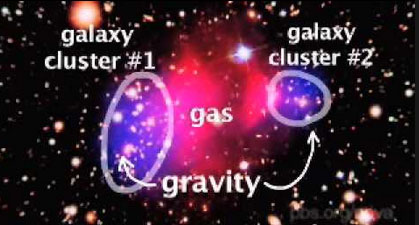
- >Top The Cosmic pie:

- ビッグバンの38万年後。
- 宇宙は等質・等方性
- 宇宙の場所による温度はほぼ一定
- 宇宙のマイクロ波の観測によってダークエネルギーを確認
- 暗黒物質と通常物質とでは電磁波の乱し方が異なる。
- ダークエネルギーの発見は超新星の測定から。
- Ia型超新星:
- 一部白色矮星の爆発による
- 明るさが一定
- 宇宙の距離を測る標準光源
>Top 3. The Big Questions:
- Pythagoras of Somos in 6C BC might have been the first to use kosmos to apply to the Universe.
- But from around AD 1200, the meaning of cosmos was "order, good order, or orderly arrangement."
- The word cosmetic, trances back to 1640s (<F. cosmétique), means "skilled in adornment or arrangement."
- Questions without answers:
- Science concerns those ideas that at least we can verify our rule out through experiments and observations.
- Philosophy concerns questions we expect well will never reliably answer.
- Technology sometime lags behind.
- Comic horizon: we can see only those regions that can be reached via a light ray during the lifetime of the Universe.; beyond the horizon is inaccessible.
- This means that science in its truest form doesn't apply beyond this domain.
- Q1: Why there is something rather than nothing?
- Nothing is so special that without an underlying reason you wouldn't expect it to characterize the state of the Universe.
- You might not always find what you are looking for, but don't randomly find nothing.
- Matter and antimatter:
- Antimatter is not dark matter.
- We don't know why it has survived as abundantly as it has to today.
- 5% of the Universe's energy - so the amount of matter in the Universe must be greater than the amount of antimatter.
- >Top Q2: Why such asymmetry remains in the universe?
- We do not understand the dark components, but we don't ever fully understand ordinary matter.
- Something special had to have occurred early in the evolution of the Universe.
- Q3: What exactly happened during the Big Bang?
- The Big Bang happened back when the Universe was less than 10−43 seconds old and the Universe was 10−33 cm big.
- No one knows what happened at the earliest moment.; no one has yet found a solvable theory that applies to this infinitesimal distance regime. (Quantum gravity)
- Q4: What came before the Big Bang?
- Answering this requires even more knowledge than understanding the Big Bang itself.
- We don't know what happened at the time of the big Band and no one knows what came before.
- If the Universe existed forever and the Big Bang was part of it, either our Universe was all there was or other universes (multiverse) also emerged from their own Big Bangs.
- Nothing about our world is inconsistent with the existence of a multiverse.
- the Big Bang explosion that happened back when the Universe was less than 10−43 seconds old and was 10−33 cm big.
3. 大いなる疑問:
- ピタゴラス:
初めてコスモスの用語
- 答えのない質問
- Q1: なぜ無ではない何かなのか
- 無はむしろ特殊
- 物質と反物質
- Q2: なぜ宇宙は非対称
- 暗黒物質は不明
- 何か特殊がことが起こった
- Q3: ビッグバンを通じて起こったこと
- 10−43 秒以前の出来事は不明
- Q4: ビッグバン以前は
- この回答はビッグバンそのものの理解より難しい
- ビッグバンに時点のことも不明なのでそれ以前はまして不明
>Top 4. Almost the very beginning; A very good place to start:
- The Big Bang Theory:
- Only the shape between the marked points would expand.
- Even in an expanding universe, stars or planets that is sufficiently tightly bound by other forces wouldn't experience the expansion that drives galaxies apart for each other.
- Our own bodies have a density in excess of a trillion times the mean density of the Universe.
- 1929: Edwin Hubble discovered that the Universe was indeed expanding, with galaxies moving farther away fro m each other over time.
- Hubble made more famous discovery - the redshift of galaxies.
- Hubble constant, which is the rat at which the Universe currently expands.
- Actually the Hubble parameter is not constant. It changes with time.
- The lifetime of the Universe depends on the inverse of the Hubble parameter.
- Einstein first derived the expansion of the universe from his equations of relativity.; In an attempt to reconcile his theory's predictions with a static universe, Einstein introduced a new source of energy which could thwart the predicted expansion. (Biggest blunder)
- The modification was not entirely erroneous; the new type of energy he added which we now call 'dark energy.'
- 13.8 B years from the Big Bang. (by The Hubble Telescopes accurate result)
- As space expanded:
- Radiation, which redshifts to lower energy dilutes every more rapidly than matter.
- Dark energy; on the other hand, doesn't dilute at all.
- As the Universe cooled, notable events occurred when its temperature and energy density no longer sufficed to produce a particular particle.
- Buy combining with antiparticles, such heavey particles annihilated, converting into energy that then heated up the remaining light particles.
- A few minutes after the Big Bang, protons and neutrons stopped flying around in isolation.
- Helium, deuterium, and lithium nuclei were then formed and the cosmic relic amount of these elements, as well as of hydrogen was established.
- Abount 380,000 years after the Big Bang, the Universe was originally filled with both charged and uncharged particlesBut at his later time, the Universe had cooled sufficiently that positively charged nuclei combined with negatively charged electrons to form neutral atoms.
- The temperature of the radiation today is 2.73K.
- The detection of this radiation was the 'smoking gun' for the Big Bang theory.
- In 1963, when Penzias and Wilson tried to calibrae theri telescope, they recorded a uniform backgroung noise that came from all directions and didn't change withe the seasons.
- After consulting witht hteoretical physicist, Robert Dicke, Penzias and Wilson recognized the import and value of what they had discovered.
- This radiation also helped advance major new insights into cosmology; helped verify the predictions of cosmological inflation.
- >Top Cosmological inflation:
- When the Big Bang theory was firest proposed in early 20C, its implications were very different from those of the theologically favored static Universe.
- Later surpise was that very early on, our Universe underwent a phase of explosive expansion - cosmological inflation.
- Inflation destoryed the contents of the Universe that had been there initially, but it also created the matter that filled our Universe.
- 10−36 seconds this sensational event called inflation took place. (>Fig.) The Universe expanded far more rapidly thatn it did uring standard Big Bang evolution - most likely exponentially.
- Once inflation ended - it left behind a large, smooth, flat homogeneous Universe whose later evolution is predicted by the tradtional Big Bang theory.
- The sky's uniformity is even more remarkael since the uniformity appplied at a precision of one in 10,000.
- It look like the Universe began with more than 100,000 regions that didn't communicate with each other.
- The inflationary Universe's extremely rapid expansion explains the Universe's enormity, uniformity, anf flatness.; it grew exponentially - in very littel time it became very big.
- >Top NASA's Cosmic Background Explorer (COBE) measured this same radiation but more comprehensively and over a large range of requencies.
- Early Universe wa not exactly uniform.
- COBE discovered the quantum fluctuation that were generat when the Universe wa roughly the size of a gran of sand.
- 2001, Wilkinson Microwave Anisotropy Probe (WMAP) measured density perturbations with even more accuracy an don smaller angular scales.
- 2009, Planck mission by European Space Agency launched its own salellite.
- Billions of years ago when structure formation toook place, the Univese changed from relatively simple system to a far more complex one.
- The distirbution of the contens of the Universe became more difficiult ot predict and interpete as strucutres such as stars, galies, and galaxy clusters.
4. ビッグバンのほぼ開始の頃:
- ビッグバン理論:
- 我々の身体は宇宙の返金みつどより1兆倍も濃集
- 1929: ハッブルによる宇宙膨張説
- アインシュタインの疑問
- ダークエネルギーを導入
- 宇宙が膨張すると
- 宇宙が冷却すると
- ビッグバン38万年後の宇宙
- import: the implicit meaning or signifi
- Cosmic History, 宇宙の歴史:
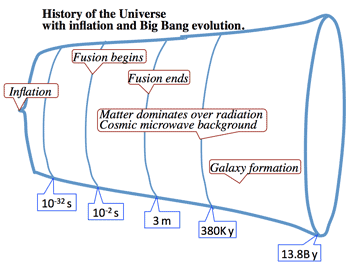
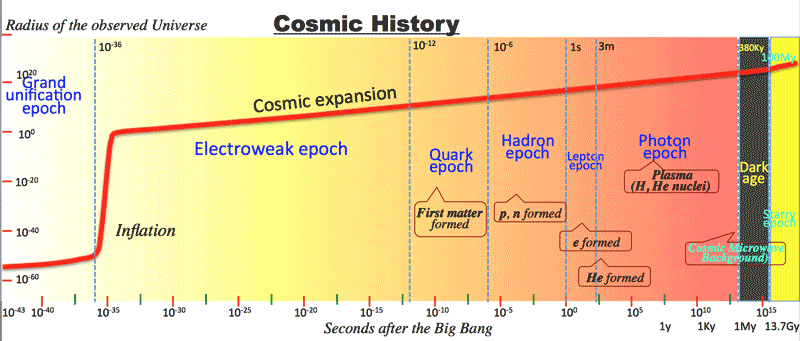
>Top WMAP (Wilkinson Mcrowave Anisotorpy Prove), 2001: Wiki
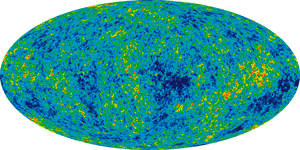
>Top 5. A Galaxy is born:
- Dark matter's critical role:
- Dark matter is neither an ominous - nor a munificent - source of strategic power in our local neighborhood.
- No one can collect it in a basement or garage; since it interacts only through gravity that have so far been too weak to detect; Earth is too small to care about.
- The enormous amount of dark matter that is spread throughout the Universe collapsed and collected to create galaxy clusters.
- The egg and the chicken:
- The theory of structure formation tells us how stars and galaxies developed from the extremely boring, uniform sky that was the final legacy of inflation.
- Initially the Universe was hot, dense, and mostly uniform; also isotropic.
- The Universe is no longer uniform. Galaxies, galaxy clusters, as well as stars, punctuate the expanse of space, staking their uneven distribution throughout the firmament.
- Binary stars constitute a stellar system, as do galaxies, which range in size from 100,000 to a trillion stars.
- Clusters of galaxies with 1000 times as many stars as that are stellar systems too.
- Galaxies:
- range in size from smaller than dwarf galaxies of about 10M sola masses to the largest galaxies with about 100T solar masses.
- The Milky way galaxy sports a smaller; about 1T solar masses (including dominant dark matter component)
- the early Universe was extremely dense, so a didn't yet contain stars or galaxies, which have far lower densities.
- almost everything satisfied this criterion because the temperature was so high, allowing radiation to dominate the Universe's energy.
- the formation of structure also had to wait until matter in the Universe carried more energy than radiation.
- As the Universe expanded, radiation and matter both diluted and so too did their energy densities.
- Since the energy in radiation dies away more quickly, matter - after waiting 100K years - eventually came to dominate the Universe's energy.
- Matter domination was significant for cosmology became slowly moving matter carries far less pressure than radiation, and there fore influences the Universe's expansion differently.
- Small, compact structures could then begin to grow. Radiation doesn't sow down enough to get trapped into small gravitationally bound systems.
- Matter can slow down and clump together. Only slowly moving matter collapses sufficiently to form structure.
- This is why that dark matter is cold, which means that it's not hot and relativistic and doesn't act like radiation.
- Gravity pulled matter in, while radiation pushed it out.
- >Top Jeans Instability:
- Gravity pulled matter in, while radiation pushed it out. The threshold beyond which this balance would be destroyed is known as the Jeans mass.
- The Universe grew lumpier as the matter rich regions grow richer and the matter poor domains go poorer.
- Stars, galaxies, and clusters of galaxies all were created at this time by gravity's effects.
- Regions collapsed sooner in the presence of dark matter than would have been possible with only ordinary matter.
- Dark matter continues to play an important role today.; Not only does it contribute to the gravitation attraction that keeps stars from flying away, but it also attracts back into galaxies some of the matter that is ejected by supernovae
- Hierarchical structure:
- Giant stars formed first, but quickly exploded into supernovae, releasing heavier elements into the Universe, or collapsed into black holes.
- After metals were present could the smaller stars form in cooler, denser regions.
- Once formed, galaxies could merge into larger structures, like galaxy clusters.
- Encounters and mergers with other galaxies are critical to their development.
- Even galaxies that appear to be isolated are surrounded by larger dark halos that are contiguous with the halos of other galaxies.
- Galaxies occupy large fraction of space; about 1 in 1,000.
- Galaxies collide far more often than stars (occupy a volume 1 in 10M)
- Today's world with increasing frequency and urgency; the poor not only become poorer; they become more numerous too.
- Dark matter correctly accounting for the density and shape of structure in the Universe. (>Cosmic web)
- The light traces overall mass density, much as the light map of the world traces the population density.
- The Milky Way: extends 130K ly and 2K in the vertical direction.; its mass about 1T solar masses.
- The center of the Milky Way contains a black hole of 4M solar mass (Sagittarius A).
- Dark matter exit in a large spherical halo about 650K ly wide.
- The reason ordinary matter lies in a disk and not a small ball is the matter's net rotation, inherited from the gas clouds.; cooling lowers resistance to collapse in one direction.
- The Solar System:
- The galaxy's net mass is dominated by dark matter, but ordinary matter, concentrated in the Milky Ways disk, dominates the physical processes in the Milky Way plane.
- Stars were formed out of the gas that collapsed to very high densities inside those haloes.
- The Sun began 4.56B years ago; The sun is located very close to the midplane
- and at a radius of about 27K ly; circles around the galaxy at 220km/s; it takes about 240M years to orbit the galactic center.
- Molecules and heavy elements play in cooling the gas sufficiently to allow for the formation of most stars.; Solar-sized star formation requires extremely cool temperatures - tens of Kelvins.
5. 銀河の誕生:
- 1 parsec ≒ 3.26 ly =206K au
- 1 au ≒ 1.5億km
- 1 M⊙ ≒ 1.99 × 1030 Kg
- ジーンズ不安定性:
The Jeans Instablity causes the collapse of interstellar gas clouds
and subsequent star formation, when the internal gas pressure is not strong enough to revent gravitational collpse.
- dpdr=−Gρ(r)Menc(r)r2
- >Top Cosmic Web of matter:
Filaments of dark matter that intersect at nodes enclose dark, relatively empy vois.
Wiki
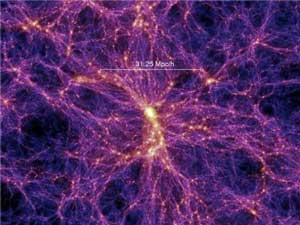
- Milky Way:
By Greek mith: Zeus brought his son Heracles home for Hera to breastfeed while she was sleeping. Hera hated Heracles, because the child was the result of one of Zeus’ affairs with Alkmenea. When Hera awoke, she quickly pushed Heracles away, which caused drops of milk to spill into the night sky. Wiki

>Top 6. Meteoroids, meteors, and meteorites:
- About 50 tons of extraterrestrial material enters the Earth' atmosphere every day.
- Blurry boundaries:
- Cf.: planetary nebula (by William Herschel in 18C): the end stage of a red giant star.
- >Top Planets: etymologically, 'wondering stars'
- The planet became increasingly restrictive:
- Planets were created after the birth of the Sun, when dust grains collected increasingly later amount of material that then collided, growing more ore less into current state in a few million or tens of million years.
- The Sun sent out charged particles that swept away H and He in the more local vicinity. So only robust materials that wouldn't melt at those temperatures, such ass Fe, Ni, Al, and Si could condense into the inner planets.
- These elements are relatively scarce, so the inner planets need time to grow.
- Farther away from the Sun (between Mars and Jupiter), volatile compounds like H2O and CH4 remain frozen as ices. Outer planets grew larger; made from material that is far more abundant than the terrestrial planets.
- For gas giant planets contain 99% of the Solar System's mass.
- >Top Ceres was a planet for 50 years after tis discovery before being reclassified as an asteroid.
- Pluto:
- The argument for Pluto's categorization.
- If we let you in, then we have to let in everyone else.; more subtle demarcations.
- Eris: discovered in 2005, about 27% heavier than Pluto.; but the margin or error was so large; had to wait for more detailed views.
- IAU (International Astronomical Union), 2006 General Assembly in Prague; changed the rules of entry.
- A planet is classified as an object that is round due to its own gravity and has cleared its neighborhood of small objects that would otherwise orbit the Sun in its vicinity.
- This means that objects such as Pluto and Eris, which are part of belts of nearby objects that orbit nearby independently, no longer rank as planets.
- Pluto was demoted in 2006 when IAU changed the planetary entry rules.
- Close flyby of Pluto in 2015/7 yielded detailed information, showing the size (not mass) of Pluto was in fact bigger.
- >Top IAU invented their term dwarf planet for objects like Pluto that fell between the cracks of asteroids and planet.; other proposed names are planetoid or subplanet.
- Dwarf planet are larger than asteroids, must be massive enough to become nearly spherical under their own gravity.; but won't have isolated orbits like true planets do.
- Dwarf planets would then be more like postdoctoral fellows, who work independently but nonetheless have offices close to the graduate students.
- Ceres is the only one in the inner Solar System.
- The farther out objects Haumea, Makemake, and Eris are officially recognized.
- Mysterious object Sedna; we will know after better measurements.
- There are more perhaps as many as 100-200 dwarf planets contained in the distant Kuiper belt.
- >Top Asteroids:
- is bigger than a meteoroid but smaller than a planet.; tens of meters across to 1000 km.
- Asteroids are the Solar System's most veteran castaways; rocky bodies, in orbit around the Sun, left over from the formation of the Solar System.; too small to be plants, too big to be ignored; they can reveal a great deal about our primordial history.
- Asteroids are usually irregularly shaped.
- S-type: most are either stony (silicate rocks) asteroids near Mars.
- C-type: carbon rich mostly found nearer to Jupiter.; particular attention of life's origins.
- Water too is a key component of life and some asteroids contain water, though comets generally contain more.
- Metallic asteroids, composed primarily of Fe and Ni exits too but are rarer.
- The asteroid belt extends from 2AU to 4AU. (250M - 600M km away)
- Outside the main belt, the orbits of Trojans, another category of asteroids, are tied to that of a larger planet or a moon ensuring their steadiness over time.
- Distribution of Asteroids:
- Planet migration:
- The inner planets migrated inward, but only a bit.
- A large number of asteroids were sent into the inner Solar System.
- 40B years ago; Late Heavy Bombardment; the heavy cratering on Moon and Mercury.
- Jupiter scattered away many of the objects originally in this region before they could coalesce.
- The total mass in the belt is measured 25th of the Moon. Ceres contains 1/3 of the amount.
- 100 times more objects that are 10 times smaller.
- Jupiter-induced early impacts might have played some role in the Earth acquiring its abundant water supply.
- Soon after the early bombardment ended about 3.8B years ago, life began to emerge.
- With only limited observational capacity it is difficult to tell the size composition or location. Only time could lead to true scientific understanding.
- The Titius-Bode law:
- The formula suggests that, extending outward, each planet would be approximately twice as far from the Sun as the one before.
- the hypothesis correctly anticipated the orbits of Ceres and Uranus.
- Meteors, Meteoroids, and Meteorites:
- <G. meteoreon, high in the sky
- Small objects that burn up in the sky are meteoroids or micrometeoroids.
- Bigger objects, which originate as either asteroids or comets, occasional make it to the Earth or its atmosphere too.
- Meteoroids:
- Most meteoroids fall apart above 75-100km in the mesosphere.
- The speed is generally on the order of tens of km/s
- Meteorites are the rocks left on Earth.
- meteorites can also arise from comets.
6. 流星体・流星・隕石:
- planetary nebula: a ring-shaped nebula formed by an expanding shell of gas round an ageing star.; 惑星状星雲
- planet; 行星 xíngxīng; 惑星
- asteroid; 小行星 xiǎoxíngxīng; , 小惑星
- Asteroids:
- Ceres:

- Titius-Bode's law:
- aAU=0.4+0.3×2n
- Mercury: n=-∞
- Vinus: 0.39AU: n=0
- Earth: 1.00AU: n=1
- Mars: 1.52AU: n=2
- Ceres: 2.77AU: n=3
- Jupiter: 9.54AU: n=4
- Saturn: 10.19AU: n=5
- Uranus: 19.19AU: n=6
- Neptune: 30.06AU: n=7?
- Pluto: 39.44AU: n=7?
>Top 7. The Short, Glorious Lives of Comets:
- Halley's comet:
- 1301/9-10; early 14C Italians gazing upward and appreciating the same astrophysical wonders that we marvel at today.
- Aristotle tried to understand the nature of comets; dry hot material would start to burn.
- >Top Nature of comets:
- Isaac Newton: the objects in the sky have to follow elliptical, parabolic, or hyperbolic orbits.
- the Great Comet of 1680; the path to a parabola.
- In 1705, using Newton's laws, Edmond Halley predicted that a come that had already appeared in 1378, 1456, 1531, 1607, and 1682 would reappear in 1758-59, Haley was the firs to suggest a comet's periodic motion and he got it right.
- 2061 will someone on Earth witness Halley's comet again.
- The current list contains about 5,000 comets, but a realistic estimate of their total number is al least 1000 time greater and could be far bigger still as high as a trillion.
- The Moon is low in volatile, since it consists mostly of silicates, with little of H, N, or C.
- Comets contain abundant volatiles, which gives dramatic tails. Comets originate well beyond Jupiter, where water and methane remain cold and frozen. Only when comets pass into the inner Solar system, the volatile materials in the comet vaporize so that they stream out.; creating an atmosphere around the nucleus called coma, which can be much bigger - thousands or even millions of km across.
- Solar wind plays an important role in this manifestation of comets.
- Comet tails can extend up to tens of millions of km. Dust hen reflects sunlight and the ions make the gases glow.
- The nucleus consists of water ice, dust, pebble-like rocks, and frozen gases including CO2, CO, CH4, and NH3.
- Comet contained minerals of Fe and Cu sulfide, which couldn't have formed without liquid water.
- The spacecraft was designed to study the comet interior and photograph the impact crater.
- The discovery of crystalline material, which requires much more extreme temperatures to form than comets currently experience, indicated either that material enter the comet from the inner Solar System or that the comet initially formed in a region distant from its current location.
- Short and long period comets:
- The demarcation between short and long periods is taken to be 200 years, but periods vary overall from a few years to several million.
- The inner regions, are called the Kuiper belts and the scattered disk, while much farther out is the hypothesized Oort cloud, which produces long-period comets.
- Halley's comet, which recurs at manageable intervals and generations of humans have observed.
- Even short-period comets might have first been kicked out of a more distant long-period orbit into a shorter-period one.
- The Kuiper belt lies between 30-55AU away. (1AU=150M km)
- It contains a large number of minor planets.
- The nuclei have irregular shapes, varying in size from a few 100 m to tens of km across.
- Comet surfaces seem to be the darkest ones in the Solar System. The dark materials absorb light, heating the ices that send out gases to become the tails.
- The only way to observe comets before they approach the Sun is through the infrared light they emit.
- The nucleus consists of water ice, dust, pebble-like rocks, and frozen gases including CO2, CO, CH4 and NH3. Nuclei surfaces appear to be rocky, with ice buried a little below the surface.
- In 1950x Fred Whipple: dirty snowball model.
- Comet contains organic compounds, such as methanol, hydrogen cyanide, formaldehyde, ethanol, and thane, as well as long-chain hydrocarbons and amino acid.
- The comet contained minerals of Fe and Cu sulfide, which couldn't have formed without liquid water - implying have initially been warmer and have been formed closer to the Sun.
- Jupiter is the biggest perturber since its mass is more than double the total mass of all the other planets combined.; like Shoemaker-Levy crashed into Jupiter in 1994.
- >Top The Kuiper Belt and the scattered disk (KBO):
- The Kuiper Belt contains more than 1000 residents know as Kuiper belt objects (KBOs) or as many as 100,000 with diameters greater than 100km.
- Despite Pluto's loss of planetary status, which is why discovered before any other object in the Kuiper belt.; Pluto 2370 km in diameter.
- Solar System formation models would assign the Kuiper belt more like 30 times the mass of the Earth.
- >Top The many other objects that have a similar orbit to Pluto are called plutinos and are located a little less than 40AU.
- 2:3 orbital resonance:
Plutinos are resonant Kuiper-belt objects, which travel in orbits that have a fixed ratio with respect to Neptune.
- Plutinos, for example, orbit the Sun twice during the time Neptune makes three trips around.
- The orbital periods of plutinos around 247.3 y (1.5×Neptune orbital period 164.79 y)
- The fixed ratio prevents the objects from getting too close to Neptune, and so they escape its stronger gravitational field that would otherwise kick them out of the region.
- Eris: the most massive and second-largest dwarf planet known in the Sola System.; discovered in 2005, which has on known moon, Dysnomia.
- >Top The Oort Cloud:
- The Oort cloud, an enormous spherically distributed cloud of icy planetesimals containing a trillion minor planets, is the hypothesized source of long-period ones.; extends from 1,000 - 50,000AU.
- Neptune rotates the Sun in about 165y at 30AU distance.
- Proxima Centauri, the nearest star - about 270K AU (4.2 ly) away.
- The Oort cloud is probably responsible for all long-period comets - such as Hale-Bopp - Halley's comet perhaps among them.
- Object that formed closer to the Sun in the dynamic early Solar System might have moved outward under the influence of gas giant planets, or the population might have arisen from unstable objects in the scattered disk.
7. 彗星の短くも光栄な寿命:
- The Adoration of the Magi by Giotto 14C. Wiki
a coment conspicuously passing over the classic nativity scene., very likeyt Halley's comet in 1301

- 彗星の分類
- Asteroid belt:
- Kuiper belt:
- Oort cloud:
- Trans-Neputunian Objects (KBO): Wiki
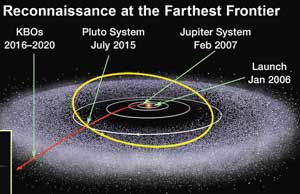
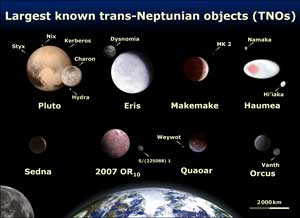
- Oort Cloud: Wiki
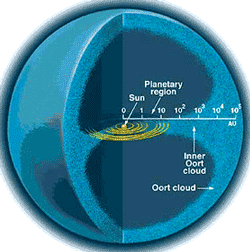
- about 1 ly=63K AU=0.306 pc
>Top 8. The Edge of the Solar System:
- In 1977, NASA launched the Voyager I and II.; it tranved more than 125AU away from the Earth.
- Its equimpment has about a million times less memory than a smartphone does today.
- In 2012/8, the spacecraft had entered intestellar space.
- The boundary of the Solar System:
- The Oort cloud extends to at least 50K au and vry likely twice as fa r(more than 1 ly).
- It would take 8-9K years to reach 50K AU, which is about a fifth the distance to the nearest star.
- The Solar wind; consists of charged particles - electrons and protons - emitted by the Sun.
- >Top These particles carry a magnetic field that streams out toward interstellar space at 400 km/s.
- The region creates a cavity called the heliosphere and the boundry between the two regions is called the heliopause.
- The signal that Voyager has reasched the edge of the helipsphere and enterd outer space would then be its ecountering a decrease of charged particles from inside the heliosphere and an increase in those from outside.
- The particles are distinguishable because they have diffrent energies, with high-energy charged particles come from the interstellar medium (ISM); as cosmic rays coming from distant supernovae.
- Voyager I carries a goldern audiovisual disk with information about human society just in case an aliien hapens to pick it.
8. 太陽系の縁:
- Interstella mission Voyager: lauched 36 years ago.; mankind most distan object.
- Carl Sagan wrote in his "Pale Blue Dot" book: "That's here. That's home. That's us. On it everyone you love, everyone you know, everyone you ever heard of, every human being who ever was, lived out their lives. … There is perhaps no better demonstration of the folly of human conceits than this distant image of our tiny world."
- Heliosphere: Wiki
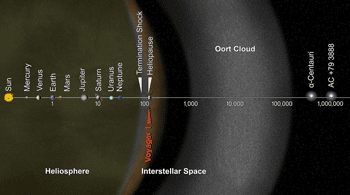
>Top 9. Living Dangerously:
- 1908, The Tunguska, Siberia, meteoroid event is the largest impact event on Earth in recorded history.
- 30-70m object. 10-15Mton - 1000 times bigger than Hiroshima A-bomb; destroyed 2,000 sq.km of forest. The impactor likely disintegrated about 6-10 km above the ground.
- Something with size in this interval might hit once every few hundred years to once in in couple of thousand.
- The blast was heard by people in France, and barometric pressure changed all over the Earth.
- 1930 Amazon in Brazil: Several smaller celestial visitors have come to Earth in 100 years since the Tunguska explosion. The net energy released was 1/100 to 1/2 as big.
- 1979 Vela Incident between South Atlantic and the Indian Ocean.
- 1994/2, Marshall Islands, the Pacific Ocean. 5-15m wide meteoroid.
- 2002 Mediterranean Sea between Greece and Libya; 25 Ktons of TNT.
- 2008 Sudan
- 2009/10 Bone, Indonesia; 10m in diameter, 50 Ktons of TNT.
- >Top 2013/2/15 Chelyabinsk, Ural, Russia; 15-20 m asteroid snucked up undetected.; 500Kton of TNT; 18km/sec 60 times the speed of sound. 1,500 people were injured by the event.
- Near-Earth Objects (NEOs):
- pretty close to Earth, with closest approach to less 30% AU.
- About 1,000 Near-Earth Asteroids (NEAs), a smaller number of comets, as do some large meteoroids.
- NEAs are divided into several categories. (>Fig)
- Amors: 1932 asteroid came within 16M km (0.11AU). They don't currently cross our path.; a fair number of bigger than 5km across.
The biggest NEA at 32km across is Ganymed. (not Ganymede one of Jupiter's moon)
- Apollos: ones that currently cross Earth's orbit. They can be above or below our ecliptic - the apparent path of the Sun that denotes the plane of the Earth' orbit.
- Atens: is named after an asteroid of its type.
- Atiras: whose orbital domains lie entirely within that of the Earth,
- NEAs are probably created by Jupiter's perturbations to the asteroid belt.
- >Top Spaceguard: IAU's Minor Plant Center reports the latest numbers of NEOs bigger than 1km.
- Current findings suggest about 940 NEAs of 1km or more in size. And 10,000 NEAs smaller than 1km.; now bigger than 140m NEAs since 2005.
- Potential Hazardous Asteroids (PHAs) within 0.05AU
- However 1km objects are expected to strike the Earth no more than once evert few hundred thousand years.
- Long-period comets: are virtually impossible to see in advance.; they come from all directions - so finding them is more difficult.
- Scientists' conclusions:
If 5-10m sized object is predicted to hit once every century, something of this size would be expected to hit cities only about once in three millennia.
- Expected Fatalities per year, worldwide:
- Shark attacks: 3-7 (expected deaths/y)
- Asteroids: 91
- Earthquakes: 36,000
- Traffic accidents: 1,200,000
- HIV/AIDA: 2,100,000
- Tobacco: 5,000,000
- How much energy an object will release: assuming at 20 km/s
-
Type of event
Diamter
Impact (MT)
Interval (y)
Airburst (Chelyabinsk)
25m
1
200
Local scale (Barringer, Tunguska)
50m
10
2,000
Regional scale
140m
300
30,000
Continental scale
300m
2,000
100,000
Global catastorophe
1km
100,000
700,000
Above Global catasgtrophe
5km
10M
30M
Mass extinction (Chicxulub)
10km
100M
100M
- What to do:
- Destruction: or
- Deflection: (Asteroid Redirect Mission)
- The Earth is pretty small and moves pretty quickly around the Sun (30km/s)
- make it arrive earlier or later by a mere 7 mininute.; by nuclear explosives as big as 1km across.
9. 辛くも生きる:
- 1908 Tunguska, Siberia:
Hiroshima A-bomb 16Kton of TNT
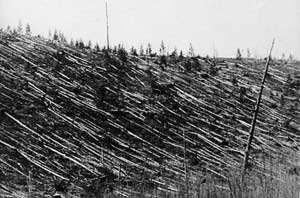
- Earth impact sites:
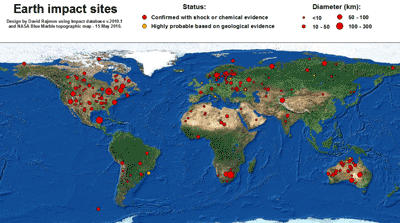
- Near Earth Object (NEO): 1000 >1km; 10,000 <1km across. Wiki
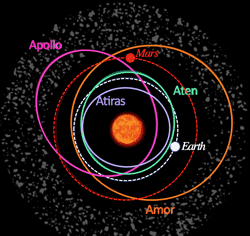
- 15,206 NEOs as of 2016/11/1: Wiki
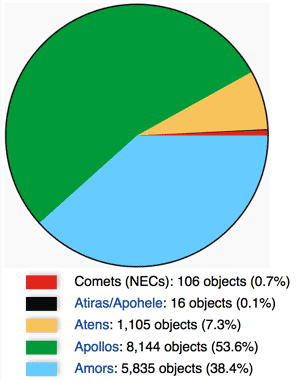
>Top Shock and Awe:
- Barriger Crater, privately owned.
- 1200m across, 170m deep, 45m risen rims.
- hit by 13km/s, generation 2MT of TNT, as much as Chelyabinsk.
- Most of the initial object was vaporized.
- In addition to FE, microscopic diamonds are found.
- 1891, Grove Karl Gilbert, US Geological Survey, concluded that it was a volcano.
- 1960, Eugen Merle Shoemaker, found rare forms of silica (coesite and stishovite) at the crater shocked by impact pressure, and showed the similarity between its geology and that produced around nuclear explosion craters in Nevada, and concluded that it was a meteoroid impact 50,000 years ago (Pleistocene epoch).
- Coesite formed in 2-3GPa; Stishovite 10Gpa
- Impact Crater Formation:
- Rocks formation: craters' geology; crater's shape, rock morphology and composition provide clues.
- Shape of impact craters;
- The shock wave - not the direct impact - is responsible for the circular shape of impact craters.
- Direct excavation would produce a depression with a preferred orientation reflection the impactor's initial direction.
- Compressed region acts like a piston; rapidly decompresses to release stress, rebounding from the initial impact and ejecting material.
- hit the ground at speeds up to 8 times the Earth escape velocity (11km/s), roughly 20-25 km/s.
- kinetic energy grows with square of the speed.
- supersonic wave creates rare crystalline structure such as shocked quarts.; shatter cones; glassy materials
- Different chemical composition including metals such as Ni, Pt, Ir, Co, which are rare on the Earth's surface.
- particular isotopes typical of extraterrestrial formations.
- Impact breccias indication an impact that shattered what was initially there.
- dikes within the crater floor formed from glass particles.
- Raised rims - not typical for volcanic craters.
- inverted stratigraphy; a consequence of material being excavated and then flipping over outside the crater.
- The hit, compression, decompression, and the outflow of the shock wave all happen within a few tenths of a second.
- The meteor crater is half its original size. Afterward, breccias and melted and ejected rock fill in the cavity. Melted material can coat the inside of the cavity.
- The impacter is bigger than 1km across, the craters formed will be 20km or larger.
- creates a hole in the atmosphere, and ejecta fill this vacuum - going upward before descending over a wide area.
- create a complex crater; the central region rises up.
- Ir-rich clay deposited.
10. 衝撃と畏怖:
- Crater: <G. kratēr, mixing bowl of wine Wiki
- Caldera: <L. caldaria, boiling pot
- Barringer Crater, Arizona: 50K yrs ago
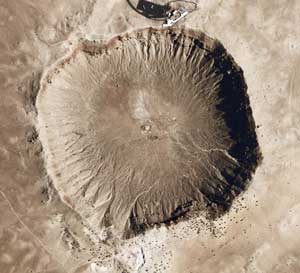
- Large known craters on Earth: Wiki
Name
Location
Dia km
age
ma
Vredefort
Free state, S.Afr
300
2023
Sudbury
Ontario
250
1849
Chicxulub
Yucatán
180
66
Popigai
Siberia
100
35
Manicouagan
Quebec
100
215
Acraman
S.Aust
90
580
Morokweng
Kalahari, S.Afr
70
145
>Top 11. Extinctions:
- Darwinian natural selection explains:
- New species emerge while species that can't successfully compete and adapt to changes in their environment - or access an alternative suitable habitat - die out.
- Darwin's ideas don't explain how life formed in the first place.
- Central to the original Darwinian conception was the notion of gradualism, change occurs slowly over many generations.
- The important element concerns how it responds to radical change, including mass extinctions, leaving no direct descendants in their wake.
- Life and death:
- Simple life emerged relatively early in the Earth history.; about 3.5B years ago after 1B after the Earth's formation.
- Oxygenic photosynthesis emerged about 1B later; precipitated the emergence of multicellular algae.
- >Top About 0.5B years later began 'the boring billion,' in which no other radical development took place.
- Phanerozoic eon: 541ma, the Cambrian explosion.; it covers 541M years to the present.
- Fossils survive as the Burgess Shale, the Yangtze Georges, eastern Siberia, and Namibia.
- >Top In early 1800s, Georges Cuvier:
- demonstrated that mastodons and mammoths weren't ancestors of any currently living animals.
- radical transition s in the fossil record were the consequences of Earth-wide catastrophes.; all extinct species were done in by catastrophic events. (Catastrophism)
- Charles Darwin:
- assumed that any evidence contradicting gradualism was simply a sign of the inadequacy of the geological or fossil record.
- Charles Lyell:
- all changes were smooth and gradual, reasoning that any so-called evidence to the contrary was simply imperfect data caused either by gaps in the geological record.
- James Hutton:
- thought the Earth changed only through tiny alterations that nevertheless yielded major effects over long periods of time. (Uniformitarianism; the present is the key to the past.)
- The evidence of dramatic changes should have been obvious.;
- Paleontologists noticed places where many fossil types suddenly ended at a boundary in the rock layer, above which evidence of new species began.
- The evidence for rapid changes became too strong to refute.
- Number of species:
- 1-2M existing species have been catalogued; the best estimate lying 8-10M.
- The extinction rate in the past is even more challenging to determine than the number of species existing today.
- Since different tie periods hosted different species, the types of fossils present help determine the relative times in which they were formed.
- But finding the absolute ages is often difficult.; isotopic analysis.
- Plate tectonics is the cause of the gradual eradication of species.; can affect climate and land coverage which can lead to dramatic modifications to life on the planet.
- Volcanic activity
- Changes of the Earth's Axis and orbit
- Cosmic rays and supernovae
- Comet or an asteroid that makes impact on Earth.; Climate changes induced
- 1982, Chicago paleontologists Jack Spkoski and David M. Raup revolutionized the field of paleobiology.
- The Big Five Extinctions:
- O-S (Ordovician-Silurian) 440ma
- Second largest extinction:
essentially all life was in the ocean back then; about 85% of all species went extinct occurred in two stages over a period of 3.5M years.
- Most of trilobite, brachiopoda, graptolithina, conodont, etc. were extinct.
- The cause seems to have initially been lower temperatures and massive glaciations that caused dramatic drops in sea level.
- The second extinction pulse was due to a later warming period and wiped out the fauna that had adapted to the cold.
- Late-D (Late Devonian) 380ma
- This event hit marine life hard too, killing a significant fraction of species in the oceans.
- Insects, plants, and proto-amphibians survived on land, though extinctions were rampant there.
- P-Tr (Permian-Triassic) 250ma
- 90% of the species on the land and in the sea died off.
- T-J (Triassic-Jurassic) 200ma
- After 5M years, new forms of mollusks, fish, insects, plants, amphibians, reptiles, early mammals and dinosaurs emerged.
- K-Pg (Cretaceous-Paleogene) 66ma
- 3/4 of the species and half the genera disappeared.
- The emergence and disappearance of life-forms certainly occurred before the Cambrian explosion too.
- Sixth Extinction?:
- Within the last 500 years, 80 mammal species have gone extinct out of total of less than 6,000.
- This mammal extinction rate has been 16 times higher than normal. Amphibians in 20C have died off at nearly 100 times higher.
- Human influence is largely to blame for the recent diversity loss, including deforestation and overfishing, and climate change.
- We would have considerably more selfish concern for our fate - especially when so many such losses can most likely be prevented.
11. 絶滅:
- 斉一説
- 天変地異節
- Kingdom界-Pylum門-Class綱-Order目-Family科-Genus属-Species種
(King-Pyl class orders family-gen speices. 界門綱目科属種j)
- The Big Five Extinction:
五大大量絶滅 Wiki
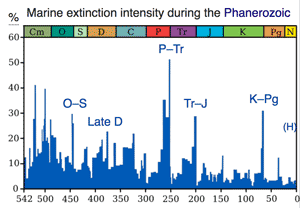
- brachiopoda, 腕足道物
- graptolithina, 筆石
- conodont, コノドント
- 6度目の大量絶滅?:
>Top The End of the Dinosaurs:
- Everyone loves the dinosaur:
- Some were big and slow and others were small and swift. Some walked on the ground, some on two legs and some on four - while some flew in the air.
- Though dinosaurs did evolve into birds that survive today, the dinosaurs that had dominated the land for millions of years went extinct about 66M years ago.
- The dinosaurs were the major players on the planet for far longer than humans or apes are likely to survive.
- Why should this diverse, vigorous group that seemed to have mastered its environment suddenly disappear at the end of the Cretaceous period?
- A meteoroid impact was almost certainly the culprit - connecting this extinction to an extraterrestrial object in the Solar System.
- A disk of dark matter in the plane of the Milky Way was responsible for triggering the meteoroid's fatal trajectory.
- The tale of how geologists, physicists, chemists, and paleontologists came to this conclusion is one of the best stories in modern science.
- >Top Dinosaur Time:
- Dinosaurs lived in the Mesozoic era (252-66ma)
- Cretaceous period: 145-66ma
- Jurassic period: 201-145ma
- Triassic period: 252-201ms
- The supercontinent Pangaea split in the Mesozoic era into the continents we see today, and resulted in extensive land movement.
- India had yet to collide with Asia and the Atlantic Ocean was much narrower.; moving at the rate of several cm/year.
- Sea levels were 100m higher than today.; temperature were higher then as well.
- During the Triassic period, arthropods, turtles, crocodilians, lizards bony fishes, sea urchins, marine reptile, and the first mammal-like reptiles arose.
- The late Triassic is also many species of dinosaurs first appeared.
- They wen on to become the dominant land vertebrates during the Jurassic period.
- >Top Birds too merged during this time, evolving from theropod dinosaurs.
- Mammals also made an appearance but they were small; between a cat and a mouse.
- Ir: Cosmic hour-glass:
- The Earth's original Ir long ago dissolved into molten iron and sank with it to the core. So any Ir on the surface should have an extraterrestrial origin.
- Ir levels on the surface should be quire low were it not for the deposition from this steady extraterrestrial rain.
- Decisive elevation in Ir levels: 90 or 160 times increase
- 500,000 ton of Ir was emitted worldwide.
- Supernovae would have led to Pu-244 in the clay.
- Os (Osmium) and Pd (Palladium) levels 1000 times higher than elsewhere.
- Meteorite hypothesis:
- Geologists tended toward the gradualist viewpoint whereas physicists went for the catastrophic.
- At the time of the Alvarez proposal, many paleontologists favored gradualist explanations. Dinosaurs died away by adverse environmental conditions, such as climate change or bad diet.
- Microscopic diamonds (and C isotope), unique amino acids (bordering limestone) are found.
- Spinels: MgAl2O4
- Volcanic origin contains more Ni, Mg
- Meteorite origin contains more Fe, Ti, Cr.
- How Life Struck Out:
-
Meteoroid
- 66 ma
- 10km across; 100M megaton of TNT
- The meteoroid, 3 times the width of Manhattan wasn't just big, but moving very quickly - at least 20 Km/s; it a comet, perhaps 3 times faster.; 700 times faster than a car of 100km/h
Crater
- Striking Paydirt: Rediscovering the Crater:
- Craters are usually about 20 times the size of the impacting object.
- 10Km object: so the crater should be about 200Km.
- A crater of the right scale from the correct date would be the smoking gun.
Energy
- Since the energy is 12mv2,m=ρ43πR3 ; (Thus, if R becomes double, the energy would be 8 times.)
- = have released 100T-tons of TNS (1B times of Hiroshima A-bomb)
Tsunami
- Near to the blast - within 1000 m - extreme winds and waves raged, and huge tsunamis radiated from the blast site. These tidal waves would have been enormously powerful.
Waves
- Tidal waves would also have appeared on the opposite side of the globe, triggered by the most massive earthquake.
Winds
- Extreme winds would have blown outward from the impact location and then rushed back in. This would have carried a cloud of superheated dust, ash, and steam.
Heat
- This wind and water would have used about 1% of the impact energy.
- The rest would have gone into melting, vaporizing, and sending seismic waves throughout the Earth.
Fires
- Trillions of tons of material would have been ejected from the site and distributed everywhere. Afterward, when the hot solid particles descended through the atmosphere.
- Fires would have raged everywhere, the Earth's surface would have been cooked and destroyed then-existing plant and animal life.
Poisonous ash
- The water, air, and soil were all poised.
- Comets contain poisonous materials such as cyanide, Ni, and Pb; heavy metal rained down from the sky. (Ejecta)
- 500K tons of iridium suddenly descended on our planet.
Acid rain
- Even more damaging would have been nitrous oxide created in the atmosphere and descended in acid rain.
- Sulfur would have been released into the atmosphere too, creating sulfuric acid and blocked sunlight,
Winter
- creating global cooling that followed the global heating, lasting perhaps for years.
Photo-synthesis
- The loss of photosynthesis would have reverberated throughout the food chain.
- More that half the world's biomass was incinerated within months.
Oceans
- The oceans didn't recover for hundreds of thousands of years.; destructive influences for 0.5-1M years afterwards. The fossils in the darkness of the limestone that contain little or no carbonates.
Creatures
- It seems no living creature survived that was heavier than about 25Kg; as a means of hiding fro the disaster - through hibernation or otherwise - would have been essential.
- Animals that could escape into the skies had better chances too.
- Rediscovering the crater:
- In 1960s, Robert Baltosser involved in a second round of exploratory drilling; suggested that it could be an impact crater.
- In 1978, Glen Penfield noticed a strong magnetic anomaly.
- In 1981, along with Pemex geologist Antonio Camargo, Penfield presented his results at the Geophysical convention in LA.
- By 1992, most geologist were convinced that the Yucatán feature was indeed an impact crater.
- In 2013, the Chicxulub impact and the mass extinction occurred less than 32,000 years apart; the impact and the extinction occurred within this very small time interval.
12. 恐竜の終焉:
- Tyrannosaurus, ティラノザウルス
18m - 20t

- Apartosaurus, アパルトザウルス
26m - 32t
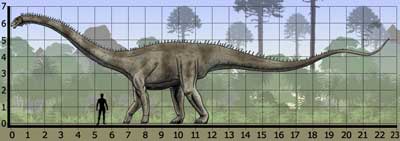
- The Mesozoic Era:
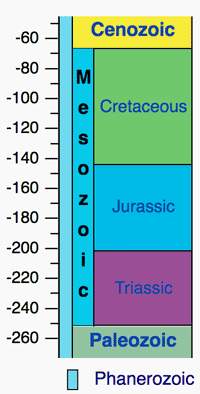
- 脊椎動物亜門 Vertebrata
- 爬虫綱 Reptilia
- 双弓亜綱 Diapsida
- 主竜形下綱 Archosauromorpha
- 恐竜上目 Dinosauria
- 竜盤目 Saurischia
- 獣脚亜目 Theropoda
- ... 始祖鳥 Archaeopteryx
- 巨大隕石衝突の結果:
- 66ma
- 上空1000mから突風と津波
- 潮汐
- 強風・灰塵・熱蒸気
- 地震波・融解・気化
- 高温固体の雨・大火災・酸性雨
- 大気の一律有毒化、重金属の雨
- 地球冷却化
- 光合成の中止
- 大洋への原状復帰は0.5-1M年
- 体重25Kg以上は生存不可
- 空への避難は少し有望
- Torino scale: Wiki
- categorizing the impact hazard associated with NEOs.; presented to UN in 1995 and was published in 1997.
- No hazad: (White)
- Normal (Green)
- Merinting attention by astronomers (Yellow)
- Threatening (Orange)
- Certain collisions (Red): collision is certain
- #8: localized destruction; occurs within 50-1000yr
- #9: regional devastation; occurs within 10-100K y
- $10: global climatic catastrophe, may theaten future civilization; occurs within 100K y or less often.
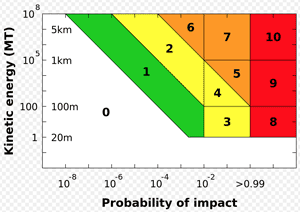
- Chelyabinsk 2013: 25m across; Scale-0: 0.5 megaton TNT
- Barringer & Tunguska 1908: 50m across: Scale-8: 3-10 megaton
- Chicxulub: 10km across: Scale-10: 100M megaton
- Gravity Anomaly in Chicxulub impact
チクシュルーブ隕石痕
structure:

>Top 13. Life in the Habitable Zone:
- We've come a long way in our journey towards the proposal that suggest how dark matter and the absence of land-dwelling dinosaurs might connect.
- The progress in science isn't involve only the known. Critically, it involves the unknown too.
- It was a long way from dark matter halos to life's creation.
- the Milky Way disk had to form, and then stars and heavy elements are more complex structures after that.
- >Top Life's Beginnings:
- The origin of life is an extremely challenging problem, especially since no one yet knows what life actually is. (
- Did it originate locally or did it come from somewhere else in outer space? (Panspermia)
- H was present in the very early Universe, but the other essential elements - C, N, O, P, and S - arose only because of hot dense stellar synthesis and supernova explosion that happened even before our Sun was born.
- 1950s, Stanley Miller and Harold Urey successfully produced amino acids with their simple apparatus, demonstrating that the production amino acids in solar and extra-solar environments is actually not so surprising.
- The term organic in chemistry simply refers to the presence of C, not necessarily to elements of life.
- Amino acids as well as purines and pyrimidines - also essential for DNA and RNA - are indeed found in space.
- >Top Chirality (or handedness):
- Only left-handed amino acids are present in life on Earth, whereas amino acids from the outer Solar System contain molecules of both handedness.
- >Top Habitable Zone:
- It is the Goldilocks region taht i sjust right to allow for stable liquid water.
- the Sun itself seems special in a few respects:
- among the more massive stars, in the top 10%.
- have higher metal content than typical
- is close to the galactic mid-plane for its age.
- have a more circular orbit than similarly aged stars.
- orbits at a somewhat similar rate to the spiral arms and therefore crosses them relatively infrequently.
- Energy:
- the chief source of energy; thousands of times greater than that of the next most significant source, geothermal heat.
- Water:
- Based of the Earth's reflectivity and the Sun's luminosity and distance, water on the Earth's surface would be frozen even today without the atmosphere's warming effect.; Liquid water currently exists on Earth only because of these greenhouse gases (CO2, CH4, Water vapor, NOx)
- Continuously habitable zone:
- the luminosity of the Sun has changed.
- within 15% of the Earth-Sun distance.
- Stability of temperature:
- relatively small temperature variations can have big effects on coastlines, agriculture, and human habitability.
- Jupiter as a bouncer:
- protecting its smaller sibling from extraterrestrial attacks.
- Heliosphere boundary:
- solar wind dominates over the interstellar medium.
- Orion Arm of the Milky Way; its relatively sparse interstellar environment.
- Meteoroids and the development of life:
- Asteroids and comets are certainly not the complete explanation fro the destruction of life.
- The K-Pg event is the only reliably established impact-induced extinction.
- The evidence that climate change and large igneous eruptions played a role in extinctions at the end of early Cambrian, the end-Permian, the end-Triassic, and the mid-Miocene is perhaps more convincing than some of the impact suggestions.
- The end-Devonian (360-400ma) is second only to the K-Pg extinction.
- Materials brought by asteroids were important for societies even before the iron age - early humans used meteoritic iron to make tools weapons, and cultural objects.
- critically important for modern era; Au, W, Ni, ad other valuable elements in the Earth's crust are accessible because of extraterrestrial objects the pelted the Earth.
- Earth's gravity pulled heavier elements into tis core and most of them won't flow back to the surface.
13. 生命居住可能領域中の生命:
- Purine: C5H4N4

- Pyrimidine: C4H4N2

- Habitable Zone,
生命居住可能領域: Wiki
- 097-1.39 AU
- If a star's luminosity is 25%: HZ is 0.5AU
- If a star's luminosity is 200%: HZ is 1.4AU
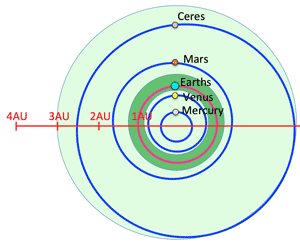
- Goldilocks zone: <The Three Bears
- CHZ: circumstellar habitable zone
- GHZ: galctic habitable zone
- within 25,000 ly (8pc)
- Habitable planet:
- Goldilocks planet:
- 62e & 62f of Lyra; 1200ly
- 62f: diameter 1.4 times, orbit 267d
- 62e: diameter 1.6 times, orbit 122d
>Top 14. What goes around comes around:
- Rutherford:
- "All science is either physics or stamp collecting."
- This arrogant statement does contain a kernel of truth. Science isn't solely about listing phenomena, no matter how beautiful and remarkable. It is about trying to understand them.
- One of the most intriguing is that objects from outer space hit the Earth on a regular basis, yielding periodic impacts by an interval between 30-35M years.
- 1920s, Milankovitch cycles:
- had theorized that variations in 1) eccentricity, 2) axial tilt, and 3) procession of the Earth's orbit strongly influence climatic patterns on Earth.
- both 20,000 year and 100,000 year approximate periodicity in temperature patterns.
- Periodicity in the crater record:
- Periodicity should include only larger craters.;
- larger than 20km that had arrived within the last 250M years.
- 250M years seemed big enough to allow for reasonable statistics but recent enough to be more reliable.
- 20km seemed a good choice for the cut-off on size as it is big enough to require an impact from 1km sized object but not so big as to preclude statistically relevant data.
- The imprints of craters is incomplete - with only a small fraction of them still visible today.
- the dating of the craters isn't always sufficiently precise.
- In 1984, Alvarez ad UC Berkeley colleague proposed 28.4M-year periodicity in carters with radius greater than 5km that were formed within the last 250M years.
- Their result was based on a sample of only 11 craters.
- Later, NY University Michael Rampino studied a sample of 41 craters between 250 and 1M years ago and identified a 31M-year period.
- In 1996, Japan suggesting a 30M-year period using craters from the last 300M years.
- 2004, Shin Yabushita of Kyoto University did a more subtle analysis with craters from the last 400M years; thereby derived a 37.5M-year period from a set of 91 craters.
- 2005, William Napier of Buckingham enter for Astrobiology, UK:
- deduced a range of scales; in which 25M-years and 35M-year seemed to dominate.; there is a relatively constant ratio of random and periodic events so that a signal wouldn't cleanly emerge.
- he suspected that comets - not asteroids - were primarily responsible for the larger ones.
- >Top LEE (Look-Elsewhere Effect):
14. 周回してやってくるもの:
- 隕石の定期的落下: 30-35M年毎
- 1984: Alvarez 28.4M-year
- Later: Rampino 31M-year
- 1996: Japan 30M-year
- 2004: Kyoto Univ. 37.5M-year
- 2005: Napier 25M & 35M-year
- どこでも効果 (LEE):
- XはYに影響するか?
- 最初の実験に失敗すると他の場所をみると、n回の試験後に1nのp値が生じる。
- 結果がp<αnとなるように閾値αを試験数nで割る必要がある。
- 失敗した試験は公表されない。→有意のInflationを起こす。
>Top 15. Flinging Comets from the Oort Cloud:
- Distinguishing the effect of comets and asteroids that have created carters is difficult.
- We do know that comets and their fragments hit the Earth less often (estimated 2-25%)
- This small rate corresponds to the low number of near-Earth comets.
- Of more than 10,000 NEOs, only about 100 of these are known to be comets.
- disproportionate amount of energy: comets 70 or more k/s as opposed to 10-30 km/s for asteroids.
- Ballistic missile travels at 11km/s
- Asteroid 20km/s; short-period comet 35km/s; long-period comet at 55km/s
- >Top 1994/7/16-22, Shoemaker-Levy comet hit on Jupiter.; the first fragment dove into Jupiter's atmosphere with a speed in excess of 60km/s. The region that was visibly affected was at least the size of the Earth.
- 17 separate pieces that spanned an arc resembling a string of pearls.
- Triggers:
- I will assume that comets from the Oort cloud are responsible for big impact.; we can potentially explain periodic hits.
- The Sun's pull on a comet in the Oort cloud is that much less strong than the Sun's pull on the Earth.; less than 100M times less strong.
- 1932, Ernst Julius Öpik proposed that perturbations to comets at the outer edge of the Solar System sometime send those icy bodies toward the inner region of the Solar System; some icy bodies would eventually become unstable and vulnerable to perturbations so that external influences would sometimes nudge them out of their or bits and into a path that was heading toward the Earth.
- A nudge's influence depends on the magnitude and frequency with which it occurs as well as the density and mass of the icy bodies it acts on.
- >Top In 1989, Julia Heisler and Scott Tremaine investigated the galactic tide caused by the Milky Way; bending the orbits of outer Solar System objects.
- The gravitation pull of the Milky Way acts differently on objects that are not in precisely the same location.
- The Sun's gravitational influence not longer suffices to maintain stable orbits
- >Top The Nemesis Proposal:
- 1984, Raup and Sepkoski:
- The first suggestion for explaining periodic impacts was that the Sun had a companion star playfully termed Nemesis; both orbited in a big binary system.
- Astronomers proposed a very elliptical orbit for this hypothetical companion to the Sun that would allow it to pass within about 30,000AU of us every 26M years.
- One problem with this proposal is that stars or interstellar clouds would make such an enormous binary system unstable, destroying the regularity of the presumed encounters.
- Observations have dramatically improved since 1984 time; should have seen this proposed red dwarf-type star had it existed - but it didn't. Having not seen a proposed Jupiter-sized gas giant planet either. (Planet-X)
- Galactic Motion:
- The Milky Way is a disk galaxy, about 130K ly across but only 2K ly in thickness. The Sun is located about 27K ly from the galactic center.
- is close to the galactic midplane - less than 100 ly away.
- These spiral arms contain more gas and dust than the regions in between.
- When the Sun crosses these denser regions, the molecular clouds exert a greater gravitational force that could cause more extensive perturbations and thereby generate a periodic enhancement in impacts.
- >Top Oscillatory vertical motion of the Solar System (Shiva Hypothesis):
- could potentially account for variations in tidal effects over time and thereby explain any periodic effects on the appropriate time scale.
- NY University Michael Rampino and Bruce Haggerty gave it a colorful name too - the Shiva hypothesis - after the Hindu god of destruction and renewal.
- Two features required for this scenario:
- the midplane density has to provide a gravitational potential that accounts for the correct oscillation period in the vertical direction.
- the change in rate that could account for periodic comet showers.
- The conclusion of all this research is that without any new ingredients, the Solar System's gravitational potential doesn't change dramatically enough over a short enough time frame to yield an observable difference in meteoroid strikes.
15. オールトの雲から放たれた彗星:
- Oort Cloud,
オールトの雲:
50K - 200K AU
- The Milky Way,
天の川銀河:
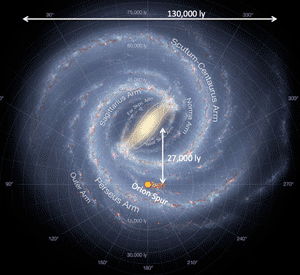
>Top 16. The Matter of the Invisible World:
- Our limited vision:
- Many objects are simply too distant to observe.; won't emit enough light to be identified.
- dust or celestial bodies might block our line of sight or obscure our view.
- something can be too small to notice. Because we see with visible wavelengths, anything smaller than the wavelength of visible light is beyond our ability to detect with the naked eye.
- the Large Hadron Collider in Geneva; we can observe physical processes at smaller sizes than ever before.
- But with dark matter, we have an even more airtight excuse not to have seen it.
- Dark matter doesn't emit or absorb light, which is essential for human vision.
- Dark matter interacts via gravity, but we don't yet know precisely what dark matter actually is.
- Model Building:
- We know dark matter's average energy density; it moves at only a fraction of the speed of light.
- it interacts at most extremely weakly with ordinary matter and with itself.
- it doesn't carry electric charge.
- we know its average density, but we don't yet know if there is one proton mass per cubic cm.
- Very often we fail to see things that we didn't expect.
- Our goal is to identify what we might be missing for lack of attention.
- In our models we make guesses for what might underlie and explain the phenomena that we know.
- Only models that make sufficiently specific predictions to be tested and distinguished from other ideas might ultimately prove interesting.
- Any single contradiction suffices to rule a model out.
- >Top WIMPS (Weakly Interacting Massive Particle):
- The interactions are indeed feeble, in the sense that dark matter does not scatter a lot as it traverses the Universe.
- the mass of the recently discovered Higgs boson particle.
- The number density of heavy particles decreased as the Universe cooled.
- Particles annihilated less efficiently as the Universe grew older and cooler.
- Stable particles with roughly the Higgs boson's mass happen to be left with about the right abundance to be the dark matter.
- WIMP dark matter doesn't interact only via gravity. It also has small nongravitational interactions with Standard Model particles.
- Asymmetric Dark Matter:
- The amount of dark matter and the amount of ordinary matter are surprisingly comparable.
- The amount of matter surpassed the amount of antimatter.
- Matter-antimatter asymmetry happed only with some special interactions and conditions in the early Universe.
- >Top Axions:
- An axion appears only in models associated with a very specific issue in particle physics known as the strong CP problem, where C stands for charge and P stands for parity.
- C- or charge-conservation says that interactions of positively and negatively charged particles are closely related.
- P- or parity-synmmetry says that no physical laws should distinguish left from right, so that, for example, particles spinning to the left and spinning to the right should have identical interactions.
- Yet not only do nature's interactions independently violate C and P. They also violate the combination together. That is to say, the violations in C and P don't compensate each other.
- >Top Neutrinos:
- In the radioactive process known as beta decay, neutrons decay to protons and electrons and neutrinos (to the antiparticles, known as antineutrinos).
- Neutrinos are particles that - like electrons, and their heavier counterpart known as muons and taus.
- Because they interact so feebly, neutrinos originally seemed like promising dark matter candidates.
- The neutrinos of the Standard Model interact via the weak nuclear force.
- Neutrinos can't be the dark matter, since their energy density is far too small.
- >Top MACHO:
- Dark matter isn't composed of novel elementary particles and is instead composed of nonburing (and hence non-light-emitting), nonreflective macroscopic structures made of ordinary stuff.
- Their role as an alternative to WIMPs behind the name.
- Since MACHOs emit little or no detectable light, they could appear to be hidden and dark even though they are composed of ordinary matter.
- MACHO candidates include black holes, neutron stars, and brown dwarfs.
- In 1990s, physicists searched from MACHOs thought a process known as microlensing. MACHOs moving through space occasionally pass in front of a star. Because light rays bend around a MACHO, it acts as a lens.
- We can be very confident that dark matter exists - even if we don't yet know what it is.
16. 見えない世界の物質:
- Cosmic Pie (Again)
宇宙パイ(物質の存在比)

- >Top The Standard Model,
素粒子標準モデル: Wiki
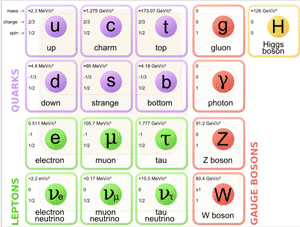
>Top 17. How to see in the dark:
- In 2013, Dark matte had not yet been found.
- If dark matter interacts solely gravitationally, or via new forces not experienced by ordinary matter, conventional dark matter searches will never find it.
- Even if Standard Model forces do act on dark matter, we still can7t be sure that the interactions are strong enough for current experiments to detect.
- Direct Detection Experiments:
- Direct detection experiments involve enormous, extremely sensitive apparatuses on Earth.
- The dark matter should travel through the material of a detector until it hits a nucleus.
- Cryogenic detectors: use for direct detection.
- are very cold devices with crystal absorbers such as germanium. They respond to the small amount of heat by using SQUIDs (Superconducting Quantum Interference Devices).
- XEBIB100 and LUX: noble gas detector.
- Even though dark matter doesn't directly interact with light, the energy added to an atom of xenon or argon when hit by a dark matter particle can potentially generate a flash of characteristic scintillation.
- 1,500m deep in the Homestake mine (originally gold mine) in South Dakota is home to the LUX experiment.
- Sudbury mine in Ontario (hit by enormous asteroid about 2B years ago) is home to several dark matter experiments.
- Indirect Detection:
- is to look for the signal that would arise if dark matter particles annihilate with dark matter antiparticles, transforming into other hopefully visible types of matter.
- Sam Ting from MIT had the idea of putting a particle detector to look for positrons and antiprotons. (AMS, Alpha Magnetic Spectrometer)
- Neutrinos that interact only via the weak force could also help with indirect dark matter detection.
- Core-cusp problem:
- The most well-known discrepancy:
- not only the type of objects that should exist in the Universe, but also how matter should be distributed within them.
- Predictions for these density profiles, as the distributions of mass with distance from objects' centers are known, are cuspy.
- This means that the dark matter density is predicted to peak rather sharply toward the centers.
17. 暗闇で見る方法:
>Top 18. Socially connected Dark Matter:
- Urbanization:
- Cities develop organically as they expand;
- Once a city becomes too dense, or other urban predicaments frequently dire people out into more sparsely settle neighborhoods, or even farther away - outside the city altogether.
- It turns out the same general pattern might apply to the growth of structure in the Universe.
- Dark matter and ordinary matter interact with each other at most very weakly.
- Numerical simulations based on dark matter that interacts solely gravitationally predict the size, density, concentration, and shapes of galaxies and clusters of galaxies.
- >Top Small-scale issues:
- Core-cusp problem: The most well-known discrepancy is known as the core-cusp problem.
- Astronomers predict not only the type of objects that should exist in the Universe, but also how matter should be distributed within them.; Predictions for these density profiles are cuspy.
- A cored density profile refers to the opposite situation - cored in the sense that matter in the center is removed.
- Observations indicate that matter densities aren't peaked nearly as strongly toward the centers of galaxies as predicted.
- Instead, the central regions' density profiles are relatively flat in these cored regions.
- Dwarf galaxies:
- orbing around larger galaxies.
- Approximately 30 dwarf galaxies found orbiting the Andromeda galaxy lie roughly in a plane
- A similarly odd distribution if found for some of the dwarf galaxies orbing the Milky Way.
- >Top Self-Interacting Dark Matter:
- Self-interacting dark matter particles would attract or repel other dark matter particles.
- Standard forces such as electromagnetism act only on ordinary matter and dark forces would act only on dark matter.
- Dark matter might scatter off other dark matter particles, but ordinary matter would be as invisible to it as dark matter is to ordinary stuff.
- If all dark matter very strongly interacted with itself - as ordinary matter does - it would act like the gas and remain in the center.
- But the bulbous outer regions indicate that dark matter didn't do that and instead passed right thought.
- Repulsive interaction among dark matter particles would keep dark matter particles apart - preventing them from piling in too closely.
18. 社会的に関連している暗黒物質:
>Top 19. The speed of Dark:
- >Top Occam's Razor:
- The simplest theory that explains a phenomenon is mot likely to be the best one.
- The best science should always encompass the broadest possible range of observations.
- The world is more complicated than any of us would have been likely to conceive.
- Some particles and properties don't seem necessary to any physical processes that matter. Yet they exist. Sometimes the simples model just isn't the correct one.
- Even if the interacting component turns out to be only a small fraction of the dark matter, it could have important implications for the Solar System and the galaxy.
- Ordinary-matter chauvinists:
- Ordinary matter (more like 15%) dominates almost everything we notice, whereas dark matter, in its abundance and ubiquity,helped create clusters and galaxies and facilitated star formation, but has only limited influence on our immediate surroundings today.
- If we were creatures made of dark matter, wold would be very wrong to assume that the particles in our ordinary matter sector were all of the same type.
- Perhaps we ordinary matter people are making a similar mistake.
- The Standard Model contains 6 types of quarks, 3 types of charged leptons including electron, 3 species of neutrinos, all the particles responsible for forces, as well as the newly discovered Higgs boson.
- It seems very odd to assume that all of dark matter is composed of only one type of particles.
- The Dark Disk:
- Heaver particles with the same temperature will have lower velocity in order for the energy to be about the same, so bigger masses lead to thinner disks.
- For a dark matter particle with mass about 100 times heavier than the proton, the disk could be about 100 times thinner even than the narrow disk of the Milky Way.
- >Top Double Disk Dark Matter (DDDM):
- There can be a thin disk of dark matter that exists along with our ordinary disk - and that this newly proposed dark matter disk can be embedded inside the well-know on of the Milky Way.
- The galaxy indeed contains two types of disks, with one embedded inside the other. (>Fig.)
- Star observations indicate that we left the center of the plane less than a could of million year ago.
- The Solar System oscillated through the dark disk around that time too.
- In fact, if the disk turns out to be a little thicker, we might even be inside it - perhaps with observable consequences.
19. ダークの速度:
- Dark Matter in the Milky Way:
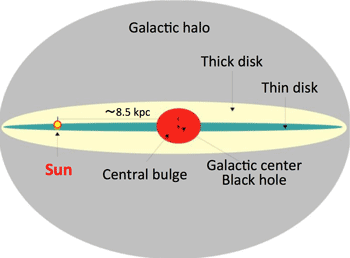
>Top 20. Searching for the Dark Disk:
- The Milky Way would contain disks of both ordinary matter and dark matter, the stars' motions in and out of the galactic plane would depend on both.
- Even richer scenario:
- Perhaps nuclear-type forces act on dark particles in addition to the electromagnetic-type one. Dark stars cold from that undergo nuclear burning to create structures that behave eve more similarly to ordinary matter than the dark matter.
- In that case, the dark dis could be populated by dark stars surrounded by dark planets made up of dark atoms. Double-disk dark matter might then have all of the same complexity of ordinary matter.
- Signs of a Dark Disk:
- A thin dark disk is dense, meaning the concentration of dark matter particles is high.
- Within the dense disk, more dark matter encounters and hence mor annihilations should occur than for dark matter distributed in a conventional cold dark matter halo.
- If dark matter also interacts with dark radiation, effects that are similar to those of ordinary matter will imprint themselves on the background radiation.
- Since our model contains both a heavy dark matter particle and a light one with opposite charge - very much akin to a proton and an electron - these particles would combine into dark atoms that would register in ways very similar to ordinary matter.
- 1989 Hipparcos satellite:
- was the first to do the detailed position and velocity measurements, but less accuracy and with fewer stars than GAIA will survey.
- 2013/12 GAIA satellite mission:
- will in effect measure the shape of the galaxy. Within 5 years we will know the result; about the mass distribution in the galaxy - no matter what type of matter or where in the galaxy it is located.
- It houses a space observatory that will measure the positions and velocities of a billion stars of the Milky Way, with the goal of crating an extremely precise and extensive 3D galactic survey.
- If this distribution demonstrated the presence of a dark disk, the disk's thickness and density will tell us in turn about the mass of the new type of dark matter particle and how much of the interacting dark matter exists.
- Before more conclusive data becomes available we won't now if DDDM models will prove to be correct or whether simpler, more standard scenarios suffice to account for the matter in our Universe.
20. ダークディスクの探査:
>Top 21. Dark Matter and Comet Strikes:
- Boffins: scientists albeit possibly overly focused ones; might have meant loony people.
- The idea was that dark matter could effective sling comets out of the Oort cloud so that they periodically catapulted into Earth, possibly even precipitating a mass extinction.
- 2013/2/15 Chelyabinsk meteoroid stuck; 15-20m wide, equivalent of 500 K-tons of TNT.
- >Top The Solar System circles around the galaxy every 240M years. With a period of perhaps 32M years, the Solar System, while traveling along its dominantly circular path, also bobbed up and down through the galactic plane.
- When the Solar System was in or close to the galactic plane, the distorting gravitational tidal effects of the disk acted on it most strongly.; might have disrupted the tranquility of some of the weakly bound objects in the Oort cloud.
- With the dark disk included in the Milky Way plane, the Sun's vertical oscillation period would be shorter than the period induced by the conventional Milky Way disk alone because the gravitation pull with the addition of the dark's matter is stronger.
- Icy bodies in the Oort cloud might get dislodged and a few might even come hurtling into our planet at about 50 am/s.
- Once set off track in this manner, the trip is quick - perhaps a few thousand years.
- If GAIA data establish the existence of a disk with the right thickness and density, it will be powerful evidence.
21. 暗黒物質と彗星の衝突:
>Top 22. Conclusion: Looking Up
- Geologists were reconstruction relatively prosaic river and land patters, while 20C physicist were radically changing the way people thought about the world and how it works.
- But as plate tectonics, stratigraphy, and geological evolution became better understood, oil reserves and mineralogical deposits were discovered and exploited.
- The transition began in 18C, but geology escalated in importance in 20C. Geology provided great dividends to our world. It literally fueled the modern industrial complex.
- This book describes as a continuation of the appreciation of other sciences; intertwining of geology, chemistry, and physics.
- That dark matter might complete the set of known relationships reinforces this continuity. Not only can we use geology to understand a cosmic event, but may be with a detailed understanding of the nature of dark matter will we come to understand the dynamics that threw a come into out path in the first place.
- Our world is rich - so rich that two of the most important questions particle physicists ask are, "Why this richness?" "How is all the matter we see related?"
- Dark matter and its role in the Universe's evolution are some of the most exciting scientific topics today.
- Understanding the galaxy and our origins within it yields a wider perspective on the felicitous accidents as well as the more predictable evolutionary processes.
- Look up. And around you. A fascinating Universe is out there for us to cultivate, cherish, and understand.
22. 結語: 見上げること
- 20Cにおける地質学の進歩
- 地質・化学・物理の総合
- 宇宙を見上げること。
Comment
- This is an integrated reference book about physics, astronomy, biology and geology. There are many interesting suggestion about answers or suggestions to many 'whys' about the Earth and origin of life.
- Dark matter - meteoroids - dinonasurs: the five-year-olds in us were intrigued!
- 本書は物理・天文・生物・地質の総合的な参考書である。地球や生命の起源についての多くのなぜに対する多くの回答や示唆がある。
- 暗黒物質・流星・恐竜となると我々の中の5歳児頃の好奇心が沸き上がる!。
- I found my old photo (around 10th year old?) when I visited a museum to see dinosaur display.
 10歳頃(左)恐竜展に行く(1955?)
10歳頃(左)恐竜展に行く(1955?)
 |
Dark Matter and The Dinosaurs- The astounding interconnectedness of the universe - |
Category: SCI |
Lisa Randall |
16z21u/18227r |
Résumé |
Remarks |
>Top 0. Introduction:
|
0. 序文:
|
>Top 1. The Clandestine Dark Matter Society:
|
1. 暗黒物質秘密結社:
|
>Top 2. The Discovery of Dark Matter:
|
2. 暗黒物質の発見:
|
>Top 3. The Big Questions:
|
3. 大いなる疑問:
|
>Top 4. Almost the very beginning; A very good place to start:
|
4. ビッグバンのほぼ開始の頃:
|
 |
>Top WMAP (Wilkinson Mcrowave Anisotorpy Prove), 2001: Wiki
|
>Top 5. A Galaxy is born:
|
5. 銀河の誕生:
|
>Top 6. Meteoroids, meteors, and meteorites:
|
6. 流星体・流星・隕石:
|
>Top 7. The Short, Glorious Lives of Comets:
|
7. 彗星の短くも光栄な寿命:
|
>Top 8. The Edge of the Solar System:
|
8. 太陽系の縁:
|
>Top 9. Living Dangerously:
|
9. 辛くも生きる:
|
>Top Shock and Awe:
|
10. 衝撃と畏怖:
|
>Top 11. Extinctions:
|
11. 絶滅:
|
>Top The End of the Dinosaurs:
|
12. 恐竜の終焉:
|
>Top 13. Life in the Habitable Zone:
|
13. 生命居住可能領域中の生命:
|
>Top 14. What goes around comes around:
|
14. 周回してやってくるもの:
|
>Top 15. Flinging Comets from the Oort Cloud:
|
15. オールトの雲から放たれた彗星:
|
>Top 16. The Matter of the Invisible World:
|
16. 見えない世界の物質:
|
>Top 17. How to see in the dark:
|
17. 暗闇で見る方法: |
>Top 18. Socially connected Dark Matter:
|
18. 社会的に関連している暗黒物質: |
>Top 19. The speed of Dark:
|
19. ダークの速度:
|
>Top 20. Searching for the Dark Disk:
|
20. ダークディスクの探査: |
>Top 21. Dark Matter and Comet Strikes:
|
21. 暗黒物質と彗星の衝突: |
>Top 22. Conclusion: Looking Up
|
22. 結語: 見上げること
|
Comment |
|
|
|
 10歳頃(左)恐竜展に行く(1955?) 10歳頃(左)恐竜展に行く(1955?) |